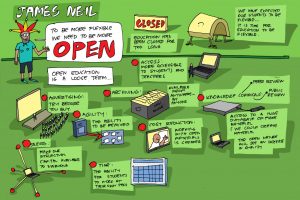Open education is an ideal way to realize the mutual resource sharing of a school and the mutual recognition of credits between schools. It is a useful exploration for the integration and communication of teacher education and non-degree education, pre-service and post-employment; it is traditional education and online education. Integrate and build the entry point of the hybrid learning model. I like to talk about the difference between open education and online education.

First, the concept is different
Online education: Network distance education is a new type of education that has emerged with the development of modern information technology.
Open education: Open education is an ideal way to realize the mutual resource sharing of a school and the mutual recognition of credits between schools.
Second, different forms of education
Online education: Network distance education is an education method that is compatible with traditional teaching forms such as face-to-face, correspondence and self-study, and a variety of media optimization combinations.
Open education: focus on students and learning, not on teachers, schools, and teaching; adopt various methods of teaching and learning; cancel and breakthrough various restrictions and obstacles to learning.
Open education does not have too many restrictions on the age, occupation, region, and academic qualifications of scholars. Anyone who has aspirations and a certain cultural and knowledge base does not need to take the entrance examination and can apply for admission.
Third, the development prospects are different
Online education: Online education has been accepted by people in all country. The world social and economic development is not balanced, and there are still differences in education levels between different regions. The rapid development of networked education will play an important role in narrowing the educational gap between regions, expanding the scale of education, and improving the quality of education. effect.
Open education: Education can be carried out under distance education or under the condition of face-to-face teaching. However, distance education is more suitable for achieving open education than face-to-face education. The combination of modern distance education and open education is what we call modern open and distance education.
Reference
https://www.google.com.hk/url?sa=i&rct=j&q=&esrc=s&source=images&cd=&ved=2ahUKEwiQ7Irjxu_jAhWKvp4KHbT_D3gQjRx6BAgBEAQ&url=https%3A%2F%2Fen.wikipedia.org%2Fwiki%2FOpen_education&psig=AOvVaw3sg4m8lb0zMwc1nmJvJPeh&ust=1565225837026677
https://en.unesco.org/courier/julio-septiembre-2017/sharing-legally-and-freely-better-learning
